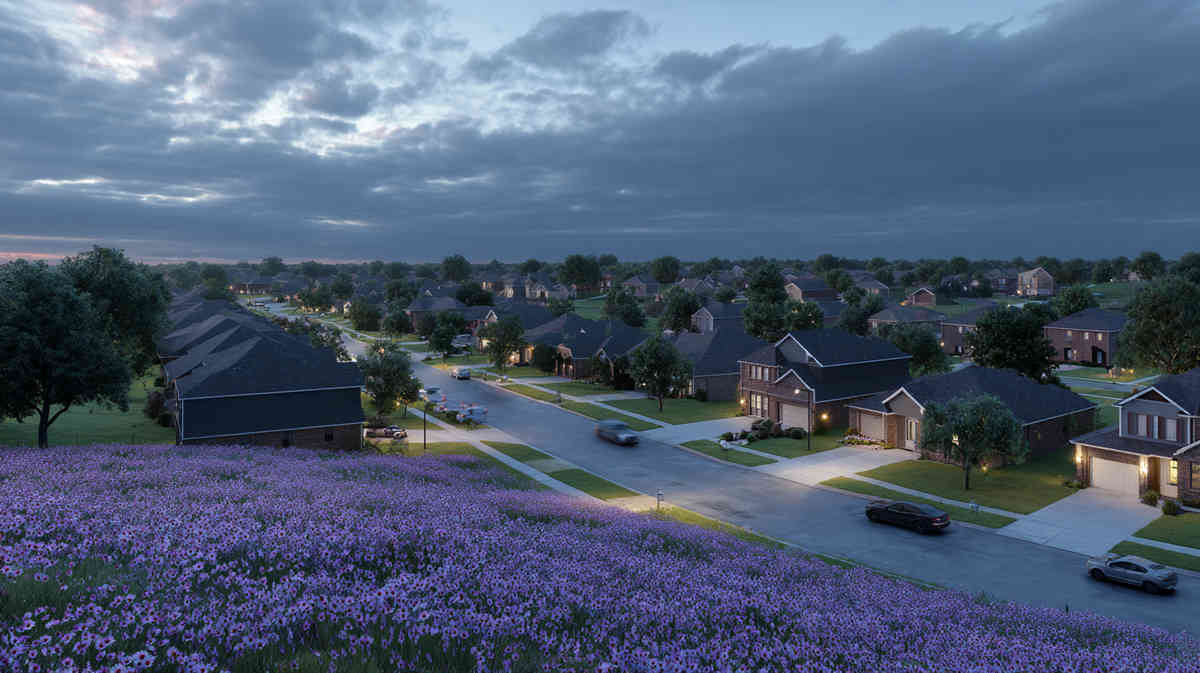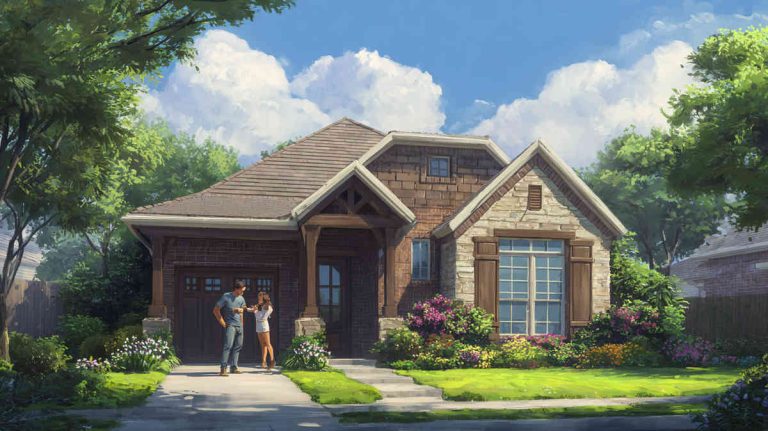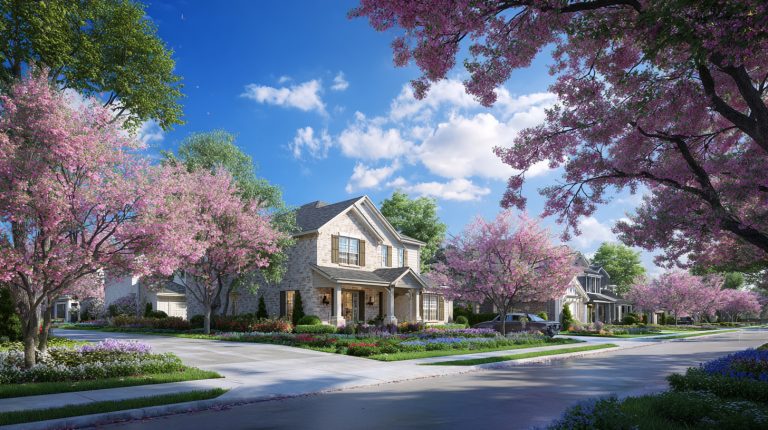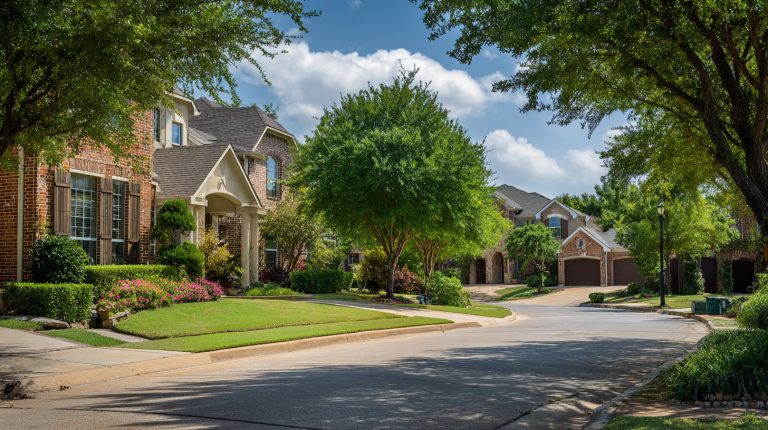Step off the highway, breathe in that pecan-sweet air, and you start to get why Flower Mound shows up on so many “best places” lists. About 77,000 people call it home right now, give or take whatever tomorrow’s relocation trucks unload. Median sales sat near $670,000 at the tail end of 2024, roughly one percent softer than last spring, and the number of active listings has crept up for three straight quarters. That mild cooling has buyers perking up while long-time owners still hold stacks of equity. New jobs keep sliding up Interstate 35 from Dallas and Fort Worth, so you are looking at a net in-migration story rather than an exodus. Ready to see what life could look like here? Keep reading.
Home Hunt Without the Drama
Real estate headlines bounce between “soft landing” and “possible spike.” On the ground things feel steadier. Average days on market hover near 43, up from the pandemic sprint but nowhere near sluggish. Sellers grudgingly hand back a few closing costs, buyers finally get inspections without ten competing bids, and everybody shakes hands with fewer ulcers.
You will notice four price bands:
- Under $500K, mostly 1980s and 1990s builds, limited inventory, move-in ready if you are cool with carpet in the dining room.
- $500K to $850K, the sweet spot, updated kitchens, three-car garages, mature trees, walking trails out the back gate.
- $850K to $1.2 million, think half-acre lots, media rooms, foam-insulated attics.
- Above $1.2 million, custom everything, iron front doors that look like bank vaults.
Lenders tightened standards last year. I watched pre-approval letters get triple-checked, so make sure yours is rock-solid. Property taxes run about 2.1 percent of assessed value. Some buyers gulp at that number until they compare it with big-city private school tuition they will not need here. HOA cultures range from loose to laser-focused. Ask for the bylaws before you fall in love with a house that forbids your dream shed.
A final note. The town has an “SMARTGrowth” plan that slows down high-density projects. Translation: your backyard view is less likely to become a tower of condos overnight.
Doorstep to Dallas, Porch to the Prairie
Daily commute questions come next. Highway 2499 slices straight through Flower Mound and ties into State Highway 121 and Interstate 635. Morning traffic builds by 7 a.m. and usually unclogs before 9 a.m. The drive to DFW International Airport takes fifteen minutes on a normal Tuesday. Catch a 6 a.m. flight without setting the alarm for 3 a.m. Nice.
Work downtown? Expect about thirty-five minutes to Las Colinas, forty-five to Uptown Dallas, roughly the same westbound to downtown Fort Worth. Carpool lanes on 121 shave off ten minutes if you time them right. No light-rail yet. Locals have lobbied, but right now the steering wheel rules.
Weekend movement feels different. Lake Grapevine hugs the town’s southern edge. Tow your boat five minutes, launch, and watch the city skyline fade while you chase white-bass boils. Cyclists favor the Northshore trail network. Road-warriors roll through Parker Square for a cold brew then pedal toward Argyle’s horse farms.
Delivery culture boomed during lockdowns and never slowed. Target runs arrive on your porch in two hours. The bigger warehouses sit in Coppell and Lewisville, so same-day shipping actually means the same day.
If you are coming from a walkable East Coast city, do a hard look at car maintenance budgets. Two cars per household feels standard here. Remote workers stash the second vehicle longer, but the minute soccer practice overlaps with a Costco run you will want the backup keys.
Green Without the Grind
The name Flower Mound is not a marketing gimmick. There is a 12-acre rise in the middle of town blanketed by wildflowers every May. Locals fought to keep it untouched. Stand at the top, turn full circle, and you spot why open-space rules matter. Pocket parks dot subdivisions, but the heavy hitters are Twin Coves, Stone Creek, and Heritage. Each one threads playgrounds, dog runs, and butterfly gardens together so your weekend feels like a mini-vacation.
Trails:
- Northshore: 22 miles, single track, some rock gardens, lake views at mile five.
- River Walk: urban-style promenade by the water, cafes on one side, waterfowl on the other.
- Timber Creek: shaded, stroller friendly, loops behind elementary schools.
Flower Mound bans commercial billboards inside town limits. That small law keeps skies cleaner than most suburbs. At night you still see Orion without downloading an astronomy app.
The Parks and Recreation crew stretches the budget creatively. Pop-up pickleball lines appear on unused tennis courts by Friday afternoon, vanish by Monday morning. Summer camp sign-ups crash the website every March, so set a reminder if you need an eight-week kid-wrangling plan. Waitlists move, but not quickly.
Finally, allergies. This is oak-and-elm territory. If you come from the desert southwest you might feel the cedar fever slam in late winter. Stock up on local honey or chat with your allergist before spring pollen season lights up.
The Pulse of Community Life
People often ask whether Flower Mound feels sleepy. My honest answer: only if you want it to. Friday nights pack the stands at high-school football games. Art-music-food mashups, like the “Chalk the Walk” street mural competition, tripled attendance numbers last year. Farmers market eggs sell out by 10 a.m., live acoustic sets push shoppers to linger, and the local candle vendor sold 400 soy-wax jars in a single morning. Hardly dull.
School chatter is everywhere. Lewisville ISD covers most of the town and posts graduation rates north of 95 percent. Keller ISD grabs a sliver on the western rim. Advanced Placement participation climbs each year. Parents love the new STEM academies, but the fine-arts kids quietly rack up statewide trophies too.
Healthcare deserves its own shout. There is a full-service medical center off 1171, a clutch of outpatient clinics, and a pediatric urgent care that saves countless road trips to Dallas. The hospital’s orthopedic wing snagged awards for post-surgical rehab protocols, which explains why you see so many weekend-warrior knees taped but still jogging across Bakersfield Park.
Dining. I counted seventeen non-chain restaurants within a three-mile radius of the Flower Mound River Walk. Sushi at Edo, street-tacos at Mi Dia, French pastries at La Belle all in one lap. Food trucks rally near Lakeside every full moon, schedule posted on Instagram by lunch.
Volunteer culture weaves everything together. Habitat build crews, animal-rescue fosters, literacy tutors, you name it. Newcomers join a project and suddenly know fifty first names by Christmas. If you relocate alone, that network flips a strange town into a comfort zone fast.
Money Matters at the End of the Month
Sticker shock can hit Texans moving in from smaller prairie towns, but most coastal transplants grin at the savings. Median household income sits near $150,000, which floats well above the national average. Groceries track just three percent over the United States index. Electric bills spike in August, no surprise. Smart thermostats slice 20 percent off if you let them learn your schedule.
Water fees can sneak up during drought-watch periods. The town uses tiered pricing to curb over-irrigation. The trick is to shift landscaping toward native plants. I swapped out a Bermuda front yard for buffalo grass and cut my summer bill in half.
Sales tax rings in at 8.25 percent, identical to Dallas. Property-tax exemptions for homestead status shave off a chunk, and the school district recently nudged the rate down by a fraction of a cent. That adjustment barely trended on social media but it saved the average homeowner about $300 last year.
Insurance is the wild card. Hail bikes through this corridor every few springs. Roof deductibles jumped after the 2023 storm season. Get an inspector who walks every shingle before you close, then budget for upgraded gutters or impact-resistant shingles down the road.
Finally, hidden costs many buyers forget:
- Toll tags for 121 and 635.
- Childcare wait-list deposits if you need Tuesday-Thursday Mother’s Day Out.
- Golf-course membership initiation fees.
- Pest control, especially if your lot backs into a greenbelt.
None of these are deal-breakers. They are simple reality checks, the kind that protect your spreadsheet from surprise red ink.
Ready to Make the Leap?
You just tore through Flower Mound’s highlights, quirks, and price tags. You learned how the market cooled just enough to breathe, why commute options feel flexible, where green space steals the spotlight, how community events keep calendars packed, and which bills deserve a second look. Put that picture together and you have a suburb with shoulders broad enough for growth yet still nimble about quality of life. If your next step is a tour, map out a weekend, talk to a local agent who knows SMARTGrowth zoning, and see whether the view from the Mound feels like home turf.
Frequently Asked Questions
How long do homes typically stay on the market right now?
Active listings average about six weeks before going under contract. Updated kitchens and three-car garages move faster, often within twenty days.
What type of internet speeds can I expect?
Fiber lines blanket most neighborhoods, pulling one-gig down speeds for roughly $70 per month. Older streets that rely on cable still clock 250 meg without throttling.
Are short-term rentals allowed in Flower Mound?
Only in specific mixed-use districts and after registering with the town. Single-family zones carry restrictions, so verify before planning any Airbnb income.
Do property taxes ever drop here?
Yes, though rarely by huge margins. Voters approved a slight rate decrease last cycle, and homestead exemptions kick in after you occupy the home as your primary residence.
What is the best time of year to move?
Early spring and late fall. Temperatures hover in the seventies, school is still in session so moving crews have more openings, and sellers negotiating after winter often throw in closing concessions.





